If a rectangle with length $\sqrt{a}$ units and width $\sqrt{b}$ units is inscribed in a circle of radius 5 units, what is the value of a + b?
A. 10
B. 20
C. 25
D. 50
E. 100
The OA is E.
The way I see it you can't solve this problem, there are a million different rectangles...I tried researching this on the internet, and everything I've read says there's an infinite number of solutions.
Please, can someone assist me with this question? Thanks in advance!
If a rectangle with length sqrt{a} units and width sqrt{b}
This topic has expert replies
-
BTGmoderatorLU
- Moderator
- Posts: 2209
- Joined: Sun Oct 15, 2017 1:50 pm
- Followed by:6 members
Timer
00:00
Your Answer
A
B
C
D
E
Global Stats
-
regor60
- Master | Next Rank: 500 Posts
- Posts: 415
- Joined: Thu Oct 15, 2009 11:52 am
- Thanked: 27 times
There may be an infinite number of rectangles, yes, but they all have one feature in common, they fit into a circle with radius 5.BTGmoderatorLU wrote:If a rectangle with length $\sqrt{a}$ units and width $\sqrt{b}$ units is inscribed in a circle of radius 5 units, what is the value of a + b?
A. 10
B. 20
C. 25
D. 50
E. 100
The OA is E.
The way I see it you can't solve this problem, there are a million different rectangles...I tried researching this on the internet, and everything I've read says there's an infinite number of solutions.
Please, can someone assist me with this question? Thanks in advance!
And because a rectangle is inscribed in the circle, the 90 degree angle of each corner subtends half the circle, meaning that the diagonal of any rectangle is also a diameter of the circle.
Since we know the diameter is always going to be 10, given the radius of 5, we know the sum of the squares of the length and width of any rectangle will equal the diameter squared, or 100, since the diameter is also a diagonal.
Length^2 = (a^1/2)^2 = a
Width^2=(b^1/2)^2 = b
therefore a+b=10^2=100
-
Shahrukh@mbabreakspace
- Junior | Next Rank: 30 Posts
- Posts: 24
- Joined: Thu Jul 05, 2018 2:28 am
Clearly, a+b is sum of squares of two adjacent sides, which is equal to diagonal^2
Also, we know, rectangle inscribed in circle will have diagonal equal to diameter(because diameter can only make 90 degree on circumference)
So, a+b= 10^2=100
Also, we know, rectangle inscribed in circle will have diagonal equal to diameter(because diameter can only make 90 degree on circumference)
So, a+b= 10^2=100
- Karishma BL
- Newbie | Next Rank: 10 Posts
- Posts: 8
- Joined: Wed Nov 10, 2010 11:43 am
- Location: Pune, India
Since the opposite sides of a rectangle are equal in length, they must be equidistant from the centre. So the diagonal of the rectangle will be the diameter of the circle. The diameter of the circle is 2*5 = 10 so the diagonal of the rectangle is 10.BTGmoderatorLU wrote:If a rectangle with length $\sqrt{a}$ units and width $\sqrt{b}$ units is inscribed in a circle of radius 5 units, what is the value of a + b?
A. 10
B. 20
C. 25
D. 50
E. 100
The OA is E.
The way I see it you can't solve this problem, there are a million different rectangles...I tried researching this on the internet, and everything I've read says there's an infinite number of solutions.
Please, can someone assist me with this question? Thanks in advance!
Using the pythagorean theorem, if the sides are sqrt(a) and sqrt(b),
[sqrt(a)]^2 + [sqrt(b)]^2 = a + b = 10^2 = 100
In case, the above step doesn't come to mind, you can just plug in value of the pythagorean triplet 3-4-5. If the diagonal is 10, the sids must be 6 and 8.
6^2 + 8^2 = 100
Note that though there are many such rectangles, you can plug in values for any one in a PS question and get the answer. The answer will be the same in every case since it is a PS question.
GMAT/MBA Expert
- ceilidh.erickson
- GMAT Instructor
- Posts: 2095
- Joined: Tue Dec 04, 2012 3:22 pm
- Thanked: 1443 times
- Followed by:247 members
"Inscribed" means that all vertices of the rectangle will touch the edge of the circle. For any given rectangle, there is only one circle that will perfectly inscribe it:BTGmoderatorLU wrote:If a rectangle with length $\sqrt{a}$ units and width $\sqrt{b}$ units is inscribed in a circle of radius 5 units, what is the value of a + b?
A. 10
B. 20
C. 25
D. 50
E. 100
The OA is E.
The way I see it you can't solve this problem, there are a million different rectangles...I tried researching this on the internet, and everything I've read says there's an infinite number of solutions.
Please, can someone assist me with this question? Thanks in advance!
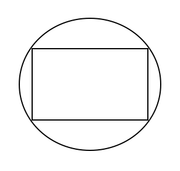
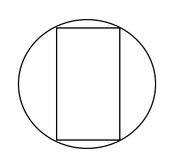
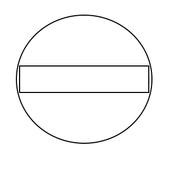
The diagonal of the inscribed rectangle must always be the DIAMETER of the circle:
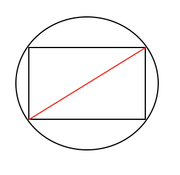
Thus, if you know the diameter of the circle, you will always know the diagonal of the rectangle.
However, to your point... there are an infinite number of rectangles that will have the same diagonal within any given circle:
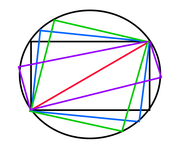
So you're right - we cannot determine the individual lengths of each side!
However... this question doesn't actually ask us for the lengths of each side individually! It just asks us for the sum (a + b). Since the side lengths of our rectangle were defined as √a and √b, then (a + b) is the sum of the squares of those sides.
Think about splitting the rectangle into two right triangles, where the diagonal is the hypotenuse. By definition in pythagorean theorem, the sum of the squares of the two non-hypotenuse sides equals the square of the hypotenuse: a^2 + b^2 = c^2. In other words, this question is really asking: what is the square of the hypotenuse (the diagonal of the rectangle).
If we know that the hypotenuse is equal to the diameter of the circle, the hypotenuse = 10. The question is simply asking us for the square of that hypotenuse, so the answer is E.
Ceilidh Erickson
EdM in Mind, Brain, and Education
Harvard Graduate School of Education
EdM in Mind, Brain, and Education
Harvard Graduate School of Education



















